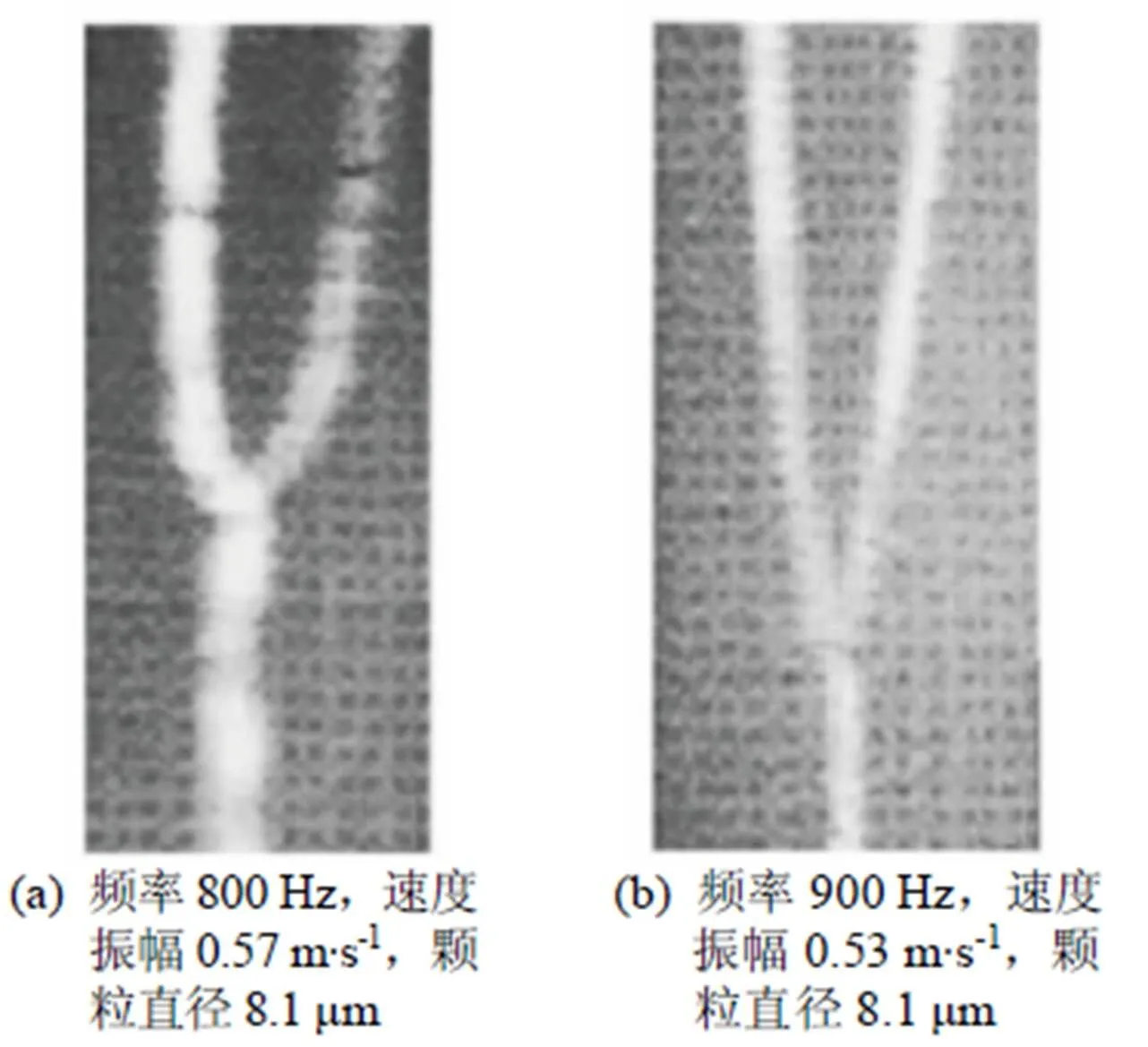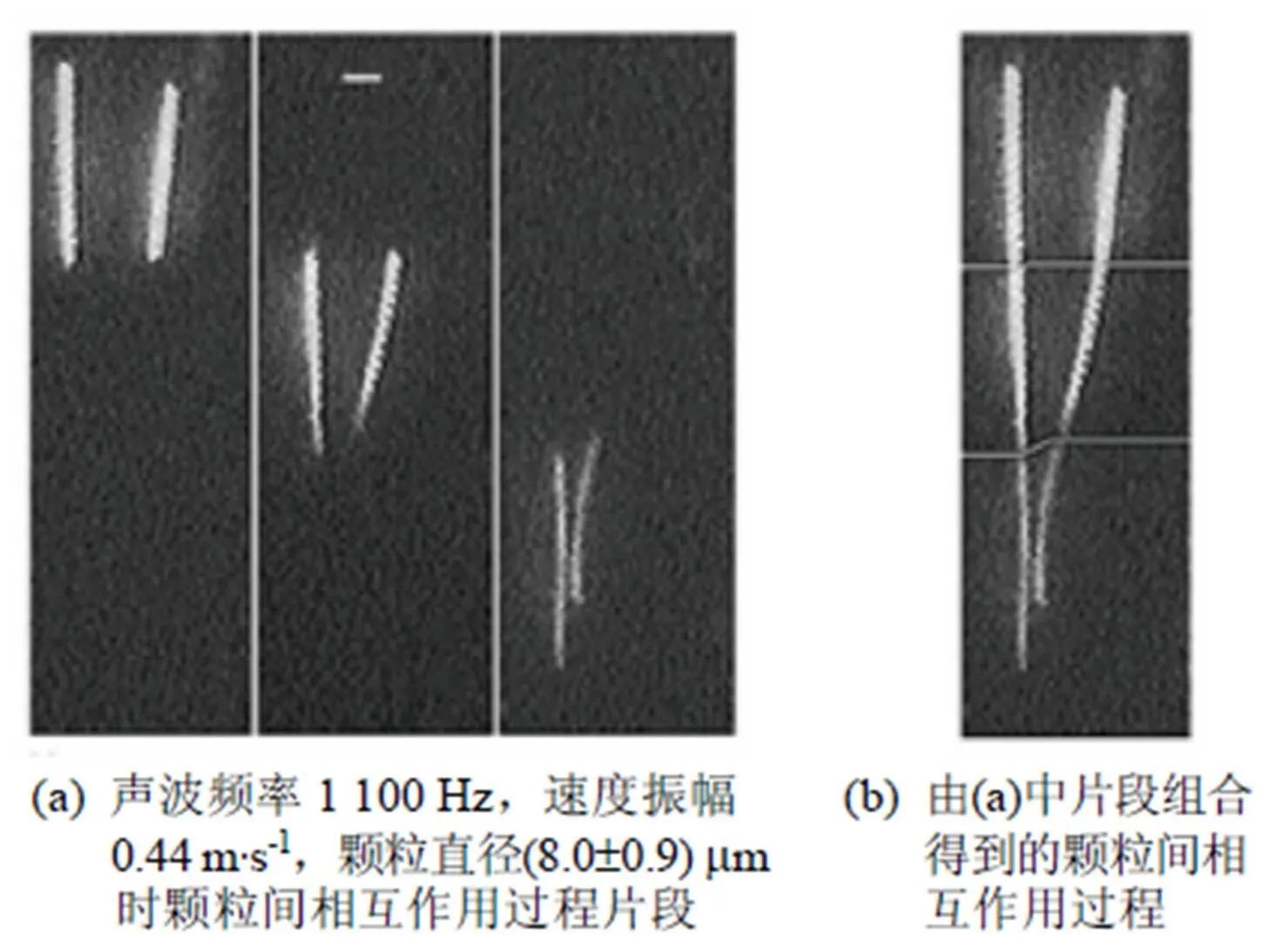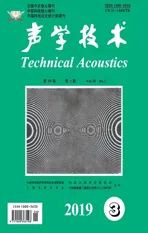声凝并中颗粒间相互作用研究进展
2019-07-19徐璇张斯宏凡凤仙
徐璇,张斯宏,凡凤仙
声凝并中颗粒间相互作用研究进展
徐璇1,2,张斯宏1,2,凡凤仙1,2
(1. 上海理工大学能源与动力工程学院,上海 200093;2. 上海理工大学上海市动力工程多相流动与传热重点实验室,上海 200093)
声凝并是细颗粒物(PM2.5)排放控制的重要技术途径,其通过外加声场作用促进PM2.5发生碰撞凝并,使得颗粒数目减少、粒径增大,从而提高后续除尘装置的效率。对声凝并中颗粒间的相互作用机理,包括同向相互作用、声尾流效应、互辐射压力效应、互散射效应的相关研究进行总结和评述,结合声凝并技术在PM2.5排放控制中的应用,指出已有研究在理论模型和实验观测上存在的问题,进而提出今后的研究应在实验方法上进行创新,发展出能够跟踪微米和亚微米尺度PM2.5颗粒或颗粒团相互作用过程细节信息的实验手段,为理论模型的实验验证提供数据支撑;同时应进一步发展理论模型,从而在模型验证的基础上,充分发挥数值模拟的优势,全面识别声凝并中颗粒间相互作用的动力学行为。
声凝并;细颗粒物(PM2.5);声场;颗粒间相互作用;作用机理
0 引言
细颗粒物(PM2.5)是我国城市大气的首要污染物,它是指空气动力学直径小于或等于2.5 μm的颗粒物,其主要来源于燃煤电站、工业过程和交通车辆的排放[1-3]。由于PM2.5粒径细微,现有的工业烟尘控制技术难以经济、高效地将其清除,造成大量的PM2.5排放到大气中,给大气环境和人群健康带来严重危害。为有效控制PM2.5的排放,PM2.5凝并预处理技术应运而生。这些技术包括声凝并[4-6]、电凝并[7]、磁凝并[8]和蒸汽相变凝并[9-10]等。其中,声凝并因装置简单、适应性强而备受研究者关注。声凝并的基本原理是利用高强度声场促进PM2.5之间发生相对运动和相互作用,进而碰撞凝并,使得颗粒数目浓度减少、粒径增大,以利于常规除尘器效率的提高,从而减少PM2.5的排放[11-14]。
对声凝并的已有研究主要集中在通过实验考察操作参数,如声场强度、频率、颗粒粒径分布、气体成分等对颗粒凝并效果的影响[15-23],以及探讨声凝并与其它机制联合作用下颗粒凝并的增强效应[24-28],而对声凝并中颗粒间相互作用机理和动态过程的研究相对较少。这严重阻碍了声凝并技术的发展。声凝并过程涉及声场对颗粒的作用、颗粒的运动对声场的影响、声波的散射等复杂的现象和过程,由此产生了多种颗粒间相互作用的机理,如同向相互作用、声尾流效应、互辐射压力效应、互散射效应等[5,29-30]。本文对声凝并中颗粒间相互作用机理的相关研究进行总结和评述,在此基础上,提出了今后开展声凝并中颗粒间相互作用研究的思路。
1 颗粒间相互作用研究发展
1.1 同向相互作用
同向相互作用是指由于颗粒在声场中受声波夹带的振动速度不同而引起颗粒靠近的相互作用机理。由于同向相互作用直接来源于声波对颗粒的夹带,因而被视为是声凝并中最基本的颗粒间相互作用机制。
1936年,BRAND等[31]基于声场中颗粒所受的Stokes力推导出颗粒振动速度的理论表达式,并对同向相互作用进行了阐述。1965年,MEDNIKOV等[32]建立了同向相互作用下颗粒凝并模型,为后续的声凝并理论和数值模拟研究提供了重要基础。为探明同向相互作用的特性,一些学者对声场中颗粒的动力学行为进行了理论、实验和数值模拟研究。1987年,CZYZ[33]对驻波声场中颗粒受到的漂移力(声辐射压力、粘性漂移力、非对称漂移力)进行理论推导和分析,指出声辐射压力在微米、亚微米尺度颗粒的漂移中所起的作用可以忽略。1990年,CZYZ[34]基于漂移力推导出颗粒浓度变化的表达式,通过理论计算进一步明确了驻波声场中颗粒的漂移主要取决于流体速度的空间变化所引起的非对称漂移力。1995年,DODEMAND等[35]将非稳定力(压力梯度力、虚拟质量力、Basset力)纳入声场中颗粒动力学模型,通过理论分析指出当颗粒与流体密度之比很小时,非稳定力对颗粒运动发挥重要作用。2000年,GONZÁLEZ等[36]对频率为20~3 500 Hz的驻波声场中直径为7.9 μm的玻璃微珠的运动规律进行实验研究,获得了颗粒的夹带系数随弛豫数(为声波角频率,为颗粒弛豫时间)的变化关系。2005年,袁竹林等[37-39]对行波和驻波声场作用下PM2.5的行为规律进行了一系列数值模拟。2007年,赵兵等[40-41]实验拍摄到微米尺度单颗粒和颗粒团在频率3 000 Hz、声压级为138 dB的驻波声场中的运动特性。同年,王春波等[42]对频率为1 000 Hz,声压级为110 dB和120 dB的行波声场中微米尺度气溶胶颗粒的运动进行了数值模拟和可视化实验。2011年,王子兵等[43]建立了同向相互作用下颗粒碰撞过程模型,研究了两颗粒逐渐靠近直至碰撞后形成双颗粒团聚体并继续运动的过程。2012年,CLECKLER等[44]考虑声场中颗粒所受Stokes力和非稳定力,建立了颗粒的无量纲运动方程,利用数值模拟方法研究了颗粒的动力学特性,发现非稳定力能否忽略除取决于颗粒与流体的密度比外,还取决于弛豫数的大小。之后,杨旭峰等[11,45-46]针对驻波声场中单个球形颗粒、球形颗粒凝并形成的直链团聚体的运动特性开展了数值模拟,并且对单颗粒运动图像在微尺度颗粒粒径测量中的应用进行了探讨。2016年,宋晓通等[47]综合考虑驻波声场中颗粒受到的粘性夹带力、非稳定力和漂移力,对颗粒漂移量随初始位置、颗粒直径、声场参数的变化规律进行数值分析。2017年,FAN等[14]进一步论述了驻波声场条件下的同向相互作用包括颗粒往复振动速度不同引起的相互作用和颗粒非对称漂移引起的相互作用;ZHOU等[48]对行波和驻波声场(频率为1 000 Hz和1 400 Hz、声压级为146、150和152 dB)中直径约为7.5 μm的单分散颗粒运动速度进行了实验研究,为颗粒的同向相互作用模型的验证提供了新依据。
1.2 声尾流效应
声尾流效应是为了解释声场中单分散颗粒和间距超过声波振幅的颗粒的快速凝并而提出的[49-50]。声尾流效应是指相邻的两个颗粒被声波夹带而发生运动时,前一颗粒后部形成一个低压尾流区域,从而使得位于该区域的后一颗粒加速向前一颗粒靠近的相互作用机制。
在上世纪五六十年代的早期研究中,提出了计算声尾流效应的方法[51],利用实验拍摄到颗粒的相互作用过程,使得声尾流效应得到了实验的支撑[52];并且推导出了基于声尾流效应的颗粒平均凝并速度表达式[53]。1989年,TEMKIN等[54]实验拍摄到直径为270 μm的水滴在激波管中的相互作用现象,发现其与声尾流效应有关。之后,HOFFMAN等[29,55]利用实验观察到粒径更小的单分散玻璃微珠(直径为8.1 μm和22.1 μm)和多分散石英颗粒(直径为25~35 μm、小于50 μm)的相互作用过程,首次发现了水平声场与重力场作用下颗粒的“音叉”凝并现象(见图1),并指出DIANOV等[53]基于声尾流效应的平均凝并速度理论模型能够预测出“音叉”凝并的大致特征,但在定量上存在不足;在此基础上,他们又推导出声尾流效应下颗粒的凝并核函数[56]。本世纪初,GONZÁLEZ等[30,57-59]建立了Oseen流条件下同向相互作用、重力、声尾流效应共同作用下颗粒相互作用的二维模型,对颗粒相互作用过程、凝并速度与碰撞时间进行了理论计算和数值模拟,并开展了不同夹带系数下颗粒相互作用实验,确认了声尾流效应是声凝并中主要的颗粒间相互作用机制。张光学等[60-61]基于GONZÁLEZ等[58]的二维颗粒相互作用模型,研究了直径在1~8 μm范围内的两颗粒的凝并特性(凝并速度、相互作用过程等)。近几年,MARKAUSKAS等[62-64]利用离散元方法建立了颗粒相互作用和凝并的二维数学模型,并对两个及多个颗粒的凝并过程和大量颗粒的凝并效果进行了数值模拟,结果表明,相比同向相互作用,声尾流效应对颗粒的凝并起主导作用。最近,ZHANG等[65]对声尾流效应产生的扰动速度进行修正,利用数值模拟方法获得了水平声场中两颗粒间相互作用过程,结果表明修正后的理论模型比DIANOV等[53]的理论模型预测结果更为准确。

图1 水平声场与重力场作用下颗粒间的音叉凝并
1.3 互辐射压力效应
互辐射压力效应是指颗粒的散射声场使得颗粒之间的气体压力发生变化,从而颗粒受到辐射压力而发生相对运动的相互作用机制[29,55]。
早在1962年就有学者提出了互辐射压力的计算方法[66]。1984年,WEISER等[67]对驻波声场颗粒的互辐射压力效应进行了实验观测和理论分析。1990年,SONG[68]推导出粘性流体中由于互辐射压力效应产生的颗粒相对运动速度。在SONG的研究基础上,HOFFMANN等[29,55]对互辐射压力效应的特征进行了数值分析,指出由于互辐射压力效应的作用距离很短,仅依靠互辐射压力效应机理无法解释实验中观察到的颗粒快速凝并现象;同时将实验观察到的两颗粒在声场中迅速靠近,达到一定距离后保持平行下降的现象称为伪凝并(见图2),并将其归因于互辐射压力效应与声尾流效应互相竞争并最终达到平衡的结果。之后,GONZÁLEZ等[30]也将实验观察到的伪凝并现象归因为互辐射压力效应的影响。然而,关于伪凝并的观点并没有得到理论计算或数值模拟的佐证。此外,MARKAUSKAS等[62-64]在利用离散元方法研究颗粒相互作用过程和特性时发现,考虑同向相互作用和声尾流效应时,所得结果与实验吻合较好,但若同时考虑互辐射压力效应,所得结果与实验差异很大,这表明互辐射压力效应无法作为颗粒相互作用机理。因此,颗粒的伪凝并及其成因仍需进一步研究。

图2 水平声场与重力场作用下颗粒间的伪凝并
1.4 互散射效应
互散射效应是指颗粒的散射声场引起的气体介质速度变化对颗粒产生作用,从而使颗粒发生相对运动的相互作用机制。
1981年,TEMKIN[69]在专著中对声场中振动颗粒形成的散射声场进行了详细的推导。1990年,SONG[68]建立了互散射效应下颗粒相互作用模型,并将互散射效应作为声凝并的再填充机理纳入声凝并模型;然而,SONG的互散射效应模型没有考虑重力的作用。HOFFMANN等[29,55]对同向相互作用、重力和互散射效应共同作用下两颗粒的相互作用进行数值模拟,得到互散射相互作用不足以作为多分散颗粒声凝并的再填充机理;同时,他们认为实验中观察到的大颗粒沉降经过小颗粒附近时,小颗粒沉降速度降低的现象可能与互散射效应有关,但缺乏对这一现象及其机制的进一步探究。2013年,FAN等[13]考虑到气体介质振动速度的空间变化,发展了行波声场中颗粒在同向相互作用、重力、声尾流效应、互散射效应共同影响下的相互作用模型,对颗粒的相互作用过程和碰撞时间进行了初步的数值模拟,但缺少对数值模拟结果的验证。因此,很有必要对声凝并中互散射效应进行进一步研究,尤其是对互散射效应的作用效果进行验证。
2 已有研究存在的问题与解决方案
2.1 存在问题
对声凝并中颗粒间相互作用理论和数值模拟研究主要进展进行归纳总结,如表1所示。由表1可知,目前对声场中颗粒间相互作用理论和数值模拟研究仍存在诸多不足。首先,已有研究往往仅考虑了同向相互作用与声尾流、互辐射压力、互散射三种效应中的一种,缺乏对多种机理共同作用下颗粒相互作用的研究。其次,数值模拟中除FAN等[13]的工作外,均未考虑气体介质振动速度在空间上的变化,使得模型应用具有局限性。再者,FAN等[13]的工作缺乏与实验的对比验证,且针对的是行波声场;驻波声场和行波声场的性质不同,有可能形成新的颗粒间相互作用行为特性。
表2给出了颗粒间相互作用实验研究主要进展。由表2可知,现有颗粒间相互作用过程实验研究仍然存在很大的局限性。一方面,实验研究中主要针对的是直径在7 μm以上的颗粒,且给出的实验结果几乎全部是单分散颗粒的相互作用过程;而声凝并的实际应用场合涉及的颗粒主要是直径在0.01~5 μm的多分散颗粒,颗粒粒径对颗粒动力学特性有重要影响,细颗粒相互作用的微观动力学行为有待进一步实验研究。另一方面,对颗粒团与颗粒团、颗粒团与单个颗粒的相互作用过程的研究仍很欠缺,相关研究仅见赵兵等[41]对单个颗粒团在声场中运动轨迹的拍摄,且研究并不系统;在声凝并实际过程中,随着颗粒的凝并,将形成结构复杂的颗粒团,颗粒间相互作用将发展为颗粒团与单颗粒间、颗粒团之间的相互作用,这些相互作用动力学行为亟待研究。

表1 颗粒间相互作用理论和数值模拟研究主要进展

表2 颗粒间相互作用实验研究主要进展
2.2 解决方案
鉴于对声凝并中颗粒间相互作用的相关研究中存在的问题,需要针对驻波声场中多机理共同作用下的颗粒间相互作用的动态过程和特性继续开展理论模型和数值模拟研究;同时在实验方法上进行创新,以克服高速显微摄像系统研究颗粒间相互作用在动力学行为方面的不足,发展出能够跟踪微米和亚微米尺度细颗粒相互作用过程细节信息的实验手段,从而通过实验考察颗粒物性参数(如粒径、形貌)对PM2.5相互作用动力学行为的影响,弥补理论研究的不足,将实验结果和理论计算相对比,进而验证、完善或修正声凝并中颗粒间相互作用理论,建立可靠的PM2.5颗粒(含颗粒团)相互作用理论模型。在上述研究基础上,充分利用数值模拟的优势,考察更为宽广的参数范围内颗粒间相互作用行为,全面识别颗粒间相互作用的行为规律。为了使得数值模拟更接近声凝并的实际应用条件,需要针对更细微的颗粒、更高的频率开展研究。例如,可结合声凝并的具体应用场合,研究热态情况下,不同气体成分下颗粒间相互作用行为;为探讨外加颗粒促进声凝并的深层机理,可开展不同种类外加颗粒(石灰石颗粒、雾化水滴)与PM2.5的相互作用过程研究;超声具有无噪声的优点,因此可开展频率大于20 kHz的超声场中颗粒相互作用特性研究。
3 结语
颗粒间相互作用是声凝并发生的基础和前提,为解释声场中颗粒快速凝并的现象,多种颗粒间相互作用的机理,包括同向相互作用、声尾流效应、互辐射压力效应和互散射效应先后被提出。然而,由于颗粒尺度的微小性与所研究问题的复杂性,已有研究还存在一些问题需要解决,声凝并中PM2.5相互作用机制和行为有待进一步确认和识别。本文对声凝并中颗粒间相互作用的理论发展和实验研究状况进行评述,指出已有研究在理论模型和实验观测上存在的问题,从而提出今后的研究中应在实验方法上进行创新,发展出能够跟踪微米和亚微米尺度PM2.5颗粒或颗粒团相互作用过程细节信息的实验手段,同时进一步发展理论模型,以采用实验观测和数值模拟相结合的方法全面识别声凝并中颗粒间相互作用的动力学行为。
[1] EHRLICH C, NOLL G, KALKOFF W D, et al. PM10, PM2.5, and PM1.0—emissions from industrial plants—results from measurement programmes in Germany[J]. Atmospheric Environment, 2007, 41(29): 6236-6254.
[2] PUI D Y H, CHEN S C, ZUO Z. PM2.5in China: Measurements, sources, visibility and health effects, and mitigation[J]. Particuology, 2014, 13(1): 1-26.
[3] 陈厚涛, 章汝心, 曹金祥, 等. 声波团聚脱除柴油机尾气中超细颗粒物的试验研究[J]. 内燃机学报, 2009, 27(2): 160-165.
CHEN Houtao, ZHANG Ruxin, CAO Jinxiang, et al. Experimental study on acoustic agglomeration of ultrafine particles in diesel engine exhaust[J]. Transactions of CSICE, 2009, 27(2): 160-165.
[4] HOFFMANN T L. Environmental implications of acoustic aerosol agglomeration[J]. Ultrasonics, 2000, 38(1): 353-357.
[5] 张明俊, 凡凤仙. 细颗粒物的声凝并数值模拟研究进展[J]. 化工进展, 2012, 31(8): 1671-1676.
ZHANG Mingjun, FAN FengxianProgress and prospect in numerical simulation on acoustic agglomeration of fine particles[J]. Chemical Industry and Engineering Progress, 2012, 31(8): 1671-1676.
[6] ZHANGG X, ZHANG L L, WANG J, et al. Improving acoustic agglomeration efficiency by addition of sprayed liquid droplets[J]. Powder Technology, 2017, 317: 181-188.
[7] 沙东辉, 骆仲泱, 鲁梦诗, 等. 带正电颗粒电凝并的显微可视化研究[J]. 浙江大学学报(工学版), 2016, 50(1): 93-101.
SHA Donghui, LUO Zhongyang, LU Mengshi, et al. Electrostatic agglomeration of positively charged particles observed by microscopic visualization system[J]. Journal of Zhejiang University (Engineering Science), 2016, 50(1): 93-101.
[8] HUANG S, PARK H, JOY. Dynamic behavior of nano-size dust particles in a magnetic field channel[J]. Journal of Nanoscience and Nanotechnology, 2016, 16(5): 4328-4334.
[9] FANF, YANG L, YAN J, et al. Experimental investigation on removal of coal-fired fine particles by a condensation scrubber[J]. Chemical Engineering & Processing, 2009, 48(8): 1353-1360.
[10] FAN F, YANGL, YAN J, et al. Numerical analysis of water vapor nucleation on PM2.5from municipal solid waste incineration[J]. Chemical Engineering Journal, 2009, 146(2): 259-265.
[11] 杨旭峰, 凡凤仙. 气温和颗粒密度对声场中颗粒动力学影响的数值模拟[J]. 声学学报, 2014, 39(6): 745-751.
YANG Xufeng, FAN Fengxian. Numerical simulation of the effects of gas temperature and particle density on particle dynamics in acoustic field[J]. Acta Acustica, 2014, 39(6): 745-751.
[12] FAN F, ZHANG M, KIM C N. Numerical simulation of interaction between two PM2.5particles under acoustic travelling wave conditions[C]//Powders and Grains 2013: Proceedings of the 7th International Conference on Micromechanics of Granular Media. AIP Conference Proceedings, 2013, 1542(1): 855-858.
[13] FAN F, YANGX, KIM C N. Direct simulation of inhalable particle motion and collision in a standing wave field[J]. Journal of Mechanical Science & Technology, 2013, 27(6): 1707-1712.
[14] FANF, ZHANG M, PENG Z, et al. Direct simulation Monte Carlo method for acoustic agglomeration under standing wave condition[J]. Aerosol & Air Quality Research, 2017, 17(4): 1073-1083.
[15] CAPERAN P, SOMERSJ, RICHTERK, et al. Acoustic agglomeration of a glycol fog aerosol: Influence of particle concentration and intensity of the sound field at two frequencies[J]. Journal of Aerosol Science, 1995, 26(4): 595-612.
[16] GALLEGO-JUFIREZ J A, De SARABIA E R F, RODRIGUEZ-CORRAL G, et al. Application of acoustic agglomeration to reduce fine particle emissions from coal combustion plants[J]. Environmental Science & Technology, 1999, 33(21): 3843-3849.
[17] 陈厚涛, 赵兵, 徐进, 等. 燃煤飞灰超细颗粒物声波团聚清除的实验研究[J]. 中国电机工程学报, 2007, 27(35): 28-32.
CHEN Houtao, ZHAO Bing, XU Jin, et al. Experimental study on acoustic agglomeration of ultrafine fly ash particles[J]. Proceedings of the CSEE, 2007, 27(35): 28-32.
[18] 徐鸿, 骆仲泱, 王鹏, 等. 声波团聚对燃煤电厂可吸入颗粒物的排放控制[J]. 浙江大学学报(工学版), 2007, 41(7): 1168-1171.
XU Hong, LUO Zhongyang, WANG Peng, et al. Acoustic agglomeration to control inhalable particulate emission from coal-fired power plants[J]. Journal of Zhejiang University (Engineering Science), 2007, 41(7): 1168-1171.
[19] LIU J, ZHANG G, ZHOU J, et al. Experimental study of acoustic agglomeration of coal-fired fly ash particles at low frequencies[J]. Powder Technology, 2009, 193(1): 20-25.
[20] LIUJ, WANG J, ZHANGG, et al. Frequency comparative study of coal-fired fly ash acoustic agglomeration[J]. Journal of Environmental Sciences, 2011, 23(11): 1845-1851.
[21] 杨振楠, 郭庆杰, 李金惠. 气氛与湿度对燃煤飞灰颗粒声波团聚的影响[J]. 化工学报, 2011, 62(4): 1055-1061.
YANG Zhennan, GUO Qingjie, LI Jinhui. Effect of atmosphere and relative humidity on particle agglomeration of fly ash in acoustic wave[J]. CIESE Journal, 2011, 62(4): 1055-1061.
[22] 康豫博, 朱益佳, 蔺锋, 等. 超细颗粒物超声波团聚的影响因素[J]. 上海交通大学学报, 2016, 50(4): 551-556.
KANG Yubo, ZHU Yijia, LIN Feng, et al. Influencing factors of acoustic agglomeration of ultrafine particles[J]. Journal of Shanghai Jiaotong University, 2016, 50(4): 551-556.
[23] 凡凤仙, 白鹏博, 张斯宏, 等. 基于声凝并的PM2.5脱除技术研究进展(I): 声凝并预处理技术[J]. 能源研究与信息, 2017, 33(3): 125-131.
FAN Fengxian, BAI Pengbo, ZHANG Sihong, et al. Research progress of acoustic agglomeration-based PM2.5removal techniques(I): pretreatment techniques of acoustic agglomeration[J]. Energy Research and Information, 2017, 33(3): 125-131.
[24] 凡凤仙, 张斯宏, 白鹏博, 等. 基于声凝并的PM2.5脱除技术研究进展(Ⅱ): 声凝并与其他机制联合作用[J]. 能源研究与信息, 2017, 33(4): 205-210, 216.
FAN Fengxian, ZHANG Sihong, BAI Pengbo, et al. Research progress of acoustic agglomeration-based PM2.5removal techniques(II): Combined effects of acoustic agglomeration with other mechanisms[J]. Energy Research and Information, 2017, 33(4): 205-210, 216.
[25] SUND, ZHANGX, FANGL. Coupling effect of gas jet and acoustic wave on inhalable particle agglomeration[J]. Journal of Aerosol Science, 2013, 66(4): 12-23.
[26] VEKTERISV, STRISHKA V, OZAROVSKIS D, et al. Experimental investigation of processes in acoustic cyclone separator[J]. Advanced Powder Technology, 2014, 25(3): 1118-1123.
[27] CHENH, LUO Z, JIANGJ, et al. Effects of simultaneous acoustic and electric fields on removal of fine particles emitted from coal combustion[J]. Powder Technology, 2015, 281(11): 12-19.
[28] YAN J, CHEN L, YANG L. Combined effect of acoustic agglomeration and vapor condensation on fine particles removal[J]. Chemical Engineering Journal, 2016, 290: 319-327.
[29] HOFFMANNT L, KOOPMANN G H. Visualization of acoustic particle interaction and agglomeration: theory and experiments[J]. J. Acoust. Soc. Am., 1996, 99(4): 2130-2141.
[30] GONZÁLEZ I, GALLEGO-JUÁREZ J A, RIERA E. The influence of entrainment on acoustically induced interactions between aerosol particles—an experimental study[J]. Journal of Aerosol Science, 2003, 34(12): 1611-1631.
[31] BRANDO, HIEDEMANN E. The aggregation of suspended particles in gases by sonic and supersonic waves[J]. Transactions of the Faraday Society, 1936, 42(190): 1101-1110.
[32] MEDNIKOV E P. Acoustic coagulation and precipitation of aerosols[M]. New York: Consultants Bureau, 1965.
[33] CZYZ H. Aerosol particle drift in a standing wave field[J]. Archives of Acoustics, 1987, 12(3): 199-214.
[34] CZYZ H. On the concentration of aerosol particles by means of drift forces in a standing wave field[J]. Acta Acustica United with Acustica, 1990, 70: 23-28.
[35] DODEMANDE, PRUD'HOMME R, KUENTZMANN P. Influence of unsteady forces acting on a particle in a suspension application to the sound propagation[J]. International Journal of Multiphase Flow, 1995, 21(1): 27-51.
[36] GONZÁLEZ I, HOFFMANN T L, Gallego J A. Precise measurements of particle entrainment in a standing-wave acoustic field between 20 and 3500 Hz[J]. Journal of Aerosol Science, 2000, 31(12): 1461-1468.
[37] 袁竹林, 李伟力, 魏星, 等. 细微颗粒在行波和驻波声场中运动特性数值实验[J]. 东南大学学报(自然科学版), 2005, 35(1): 140-144.
YUAN Zhulin, LI Weili, WEI Xing, et al. Numerical simulation of moving behavior of PM2.5in sound wave field[J]. Journal of Southeast University (Natural Science Edition), 2005, 35(1): 140-144.
[38] 袁竹林, 李伟力, 魏星, 等. 声波对悬浮PM2.5作用的数值研究[J]. 中国电机工程学报, 2005, 25(8): 121-125.
YUAN Zhulin, LI Weili, WEI Xing, et al. Study of the sound wave effect on the PM2.5suspended in the air by numerical method[J]. Proceedings of the CSEE, 2005, 25(8): 121-125.
[39] 袁竹林, 凡凤仙, 姚刚, 等. 声波对悬浮PM2.5作用的数值模拟与实验研究[J]. 燃烧科学与技术, 2005, 11(4): 298-302.
YUAN Zhulin, FAN Fengxian, YAO Gang, et al. Study of sound wave effect on the PM2.5suspended in the air by numerical simulation and experiments[J]. Journal of Combustion Science and Technology, 2005, 11(4): 298-302.
[40] 赵兵, 姚刚, 沈湘林. 燃煤可吸入颗粒物在驻波声场中动力学特性的研究[J]. 中国电机工程学报, 2007, 27(26): 13-17.
ZHAO Bing, YAO Gang, SHEN Xianglin. Study on the dynamical behavior of inhalable particle from coal combustion in a standing wave field[J]. Proceedings of the CSEE, 2007, 27(26): 13-17.
[41] 赵兵, 姚刚, 杨林军, 等. 燃煤细颗粒和颗粒团动力学特性的比较[J]. 中国电机工程学报, 2007, 27(8): 1-4.
ZHAO Bing , YAO Gang, YANG Linjun, et al. Comparison of dynamical behavior between fine particles and aggregates from coal combustion[J]. Proceedings of the CSEE, 2007, 27(8): 1-4.
[42] 王春波, 李群, 陈鸿伟. 水平平面声波对重力场中PM2.5颗粒作用的数值模拟及实验研究[J]. 中国电机工程学报, 2007, 27(23): 18-23.
WANG Chunbo, LI Qun, CHEN Hongwei. Experiments and numerical simulation of the PM2.5driven by level sound wave in gravitational field[J]. Proceedings of the CSEE, 2007, 27(23): 18-23.
[43] 王子兵, 钟晓晖, 闫永欣, 等. 声场中PM2.5颗粒碰撞运动模型[J]. 环境工程学报, 2011, 5(12): 2839-2843.
WANG Zibing, ZHONG Xiaohui, YAN Yongxin, et al. Particles collision model of PM2.5in sound field[J]. Chinese Journal of Environmental Engineering, 2011, 5(12): 2839-2843.
[44] CLECKLER J, ELGHOBASHI S, LIUF. On the motion of inertial particles by sound waves[J]. Physics of Fluids, 2012, 24(3): 935-937.
[45] 杨旭峰, 凡凤仙. 驻波声场中直链颗粒团聚体运动的数值模拟[J]. 动力工程学报, 2015, 35(4): 287-291.
YANG Xufeng, FAN Fengxian. Numerical simulation on motion of chain-like particle aggregates in standing wave acoustic field[J]. Journal of Chinese Society of Power Engineering, 2015, 35(4): 287-291.
[46] 杨旭峰, 凡凤仙. 声波夹带法测量可吸入颗粒物粒径的误差和范围[J]. 动力工程学报, 2016, 36(3): 196-200.
YANG Xufeng, FAN Fengxian. Error and range in measurement of inhalable particle sizes by acoustic entrainment method[J]. Journal of Chinese Society of Power Engineering, 2016, 36(3): 196-200.
[47] 宋晓通, 凡凤仙. 驻波声场中可吸入颗粒物漂移的影响因素分析[J]. 热能动力工程, 2016, 31(1): 75-82.
SONG Xiaotong, FAN Fengxian. Analysis of the factors influencing the drift of inhalable particles in a standing wave acoustic field[J]. Journal of Engineering for Thermal Energy and Power, 2016, 31(1): 75-82.
[48] ZHOUD, LUOZ, FANGM, et al. Numerical calculation of particle movement in sound wave fields and experimental verification through high-speed photography[J]. Applied Energy, 2016, 185: 2245-2250.
[49] SHAWD T, TUK W. Acoustic particle agglomeration due to hydrodynamic interaction between monodisperse aerosols[J]. Journal of Aerosol Science, 1979, 10(3): 317-328.
[50] TIWARY R, REETHOFG. Effect of hydrodynamic interaction between small particles on fill up of agglomeration volume in acoustic agglomeration of aerosols[C]//The ASME Winter Annual Meeting, Boston, MA, USA, 1987. New York: The American Society of Mechanical Engineers.
[51] PSHENAI-SEVERIN S V. On the convergence of aerosol particles in a sound field under the action of the Oseen hydrodynamic forces[J]. Doklady Akademii Nauk SSSR, 1959, 125(4): 775-778.
[52] SHIROKOV N L, ÉKNADIOSYANTS O K. Interaction of aerosol particles in an acoustic field[J]. Soviet Physics-Acoustics. 1966, 11: 346-348.
[53] DIANOV D V, PODOLSKIIA A, TURUBAROVV L. Calculation of the hydrodynamic interaction of aerosol particles in a sound field under Oseen flow conditions[J]. Soviet Physics-Acoustics, 1968, 13(3): 314-319.
[54] TEMKIN S, ECKER G Z. Droplet pair interactions in a shock-wave flow field[J]. Journal of Fluid Mechanics, 1989, 202: 467-497.
[55] HOFFMANN T L, KOOPMANN G H. Visualization of acoustic particle interaction and agglomeration: Theory evaluation[J]. Journal of Acoustical Society of America, 1997, 101(6): 3421-3429.
[56] HOFFMANN T L. An extended kernel for acoustic agglomeration simulation based on the acoustic wake effect[J]. Journal of Aerosol Science, 1997, 28(6): 919-936.
[57] GONZÁLEZ I, HOFFMANN T L, GALLEGO-JUÁREZ J A. Theory and calculation of sound induced particle interactions of viscous origin[J]. Acustica, 2000, 86(5): 784-797.
[58] GONZÁLEZ I, ELVIRA L, HOFFMANN T L, et al. Numerical study of the hydrodynamic interaction between aerosol particles due to the acoustic wake effect[J]. Acustica, 2001, 87(4): 454-460.
[59] GONZÁLEZ I, HOFFMANN T L, GALLEGO JA. Visualization of hydrodynamic particle interactions: validation of a numerical model[J]. Acta Acustica United with Acustica, 2002, 88(1): 19-26.
[60] ZHANG G X, LIU J Z, WANG J, et al. Numerical simulation of acoustic wake effect in acoustic agglomeration under Oseen flow condition[J]. Chinese Science Bulletin, 2012, 57(19): 2404-2412.
[61] 张光学, 刘建忠, 王洁, 等. 声波团聚中尾流效应的理论研究[J]. 高校化学工程学报, 2013, (2): 199-204.
ZHANG Guangxue, LIU Jianzhong, WANG Jie, et al. Theoretical study of acoustic wake effect in acoustic agglomeration[J]. Journal of Chemical Engineering of Chinese Universities, 2013, (2): 199-204.
[62] MARKANUSKAS D, KAIANAUSKAS R, MAKANICKAS A. Numerical particle-based analysis of the effects responsible for acoustic particle agglomeration[J]. Advanced Powder Technology, 2015, 26(3): 698-704.
[63] MARKAUSKAS D, MAKNICKAS A, KAČIANAUSKAS R. Simulation of acoustic particle agglomeration in poly-dispersed aerosols[C]//New Paradigm of Particle Science and Technology-Proceedings of the 7th World Congress on Particle Technology. Procedia Engineering, 2015, 102: 1218-1225.
[64] MAKNICKAS A, MARKAUSKAS D, KAČIANAUSKAS R. Discrete element simulating the hydrodynamic effects in acoustic agglomeration of micron-sized particles[J]. Particulate Science & Technology, 2016, 34(4): 453-460.
[65] ZHANG G X, ZhANG L L, WANG J Q, et al. A new model for the acoustic wake effect in aerosol acoustic agglomeration processes[J]. Applied Mathematical Modelling, 2018, 61: 124-140.
[66] EMBLETONT F W. Mutual interaction between two spheres in a plane sound field[J]. J. Acoust. Soc. Am., 1962, 34(12): 1714-1720.
[67] WEISER M A H, APFEL R E, NEPPIRAS E A. Interparticle forces on red cells in a standing wave field[J]. Acta Acustica united with Acustica, 1984, 56(2): 114-119.
[68] SONG L. Modeling of Acoustic Agglomeration of Fine Aerosol Particles[D]. University Park: Pennsylvania State University, 1990.
[69] TEMKINS. Elements of Acoustics[M]. New York: John Wiley & Sons, 1981: 445-454.
Research progress on particle interaction in acoustic agglomeration
XU Xuan1,2, ZHANG Si-hong1,2, FAN Feng-xian1,2
(1. School of Energy and Power Engineering, University of Shanghai for Science and Technology, Shanghai 200093, China;2. Shanghai Key Laboratory of Multiphase Flow and Heat Transfer in Power Engineering, University of Shanghai for Science and Technology,Shanghai 200093, China)
Acoustic agglomeration is an important technical approach to control the emission of fine particles (PM2.5). An external acoustic field can promote the particle collision and agglomeration, and make particle number decrease and particle diameter increase, hence the efficiency of the subsequent dust removal device can be improved. The relevant researches on the particle interaction mechanisms in acoustic agglomeration, including orthokinetic interaction, acoustic wake effect, mutual radiation pressure effect and mutual scattering effect are summarized and reviewed in this paper. Combined with the application of acoustic agglomeration technique in emission control of PM2.5, the problems existing in the previous researches on theoretical models and experimental observations are presented. Based on this, a proposal of developing novel experimental approaches, which can track the detailed information of the interaction between micrometer and sub-micrometer sized PM2.5particles or particle agglomerates should be developed,is put forward in order to provide data support for the experimental verification of the theoretical models in further studies. Meanwhile, the theoretical model should be further developed, thus the dynamical behaviors of particle interaction in acoustic agglomeration can be comprehensively identified by taking full advantage of the numerical simulation on the basis of model validation.
acoustic agglomeration; fine particle (PM2.5); acoustic field; particle interaction; interaction mechanism
X513
A
1000-3630(2019)-03-0241-07
10.16300/j.cnki.1000-3630.2019.03.001
2018-05-19;
2018-07-18
国家自然科学基金项目(51206113, 51776129)、上海市科委科研计划项目(13DZ2260900)
徐璇(1994-), 女, 湖北天门人, 硕士研究生, 研究方向为燃烧源细颗粒物声凝并技术。
凡凤仙,E-mail: fanfengxian@hotmail.com
